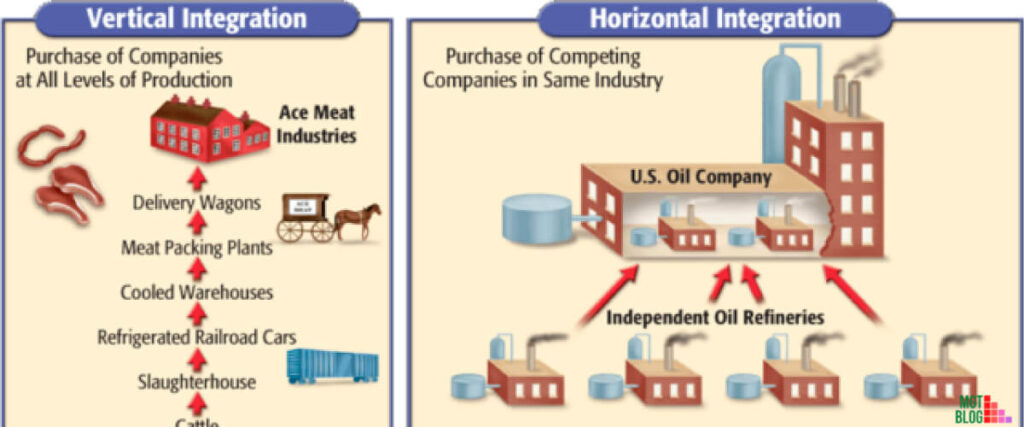Vertical integration occurs between two firms that operate at different stages of the supply chain. It helps organizations to achieve synergy with self-sufficiency. Horizontal Integration, on the other hand, materializes between two firms that have similar operations in terms of production and product level. It helps the organizations to achieve synergy, but not with self-sufficiency to operate alone in the value chain.
Key Takeaways
- Horizontal integration is a type of business development strategy where a company or an organization decides to acquire the same type of products at the same level of marketing or production process in a merger
- Vertical integration is a type of business expansion strategy where a company takes complete control of different stages of the supply chain to gain control over the entire market industry
- Vertical integration is available in two types: forward and backward integration
- You have to consider both short-term and long-term growth objectives when you want to choose between horizontal and vertical integration
What Is Horizontal Integration In Business?
Horizontal integration is a type of business development strategy where a company or an organization decides to acquire the same type of products at the same level of marketing or production process in a merger. When a company decides to take up another company at the same level of the value chain or from the same business line to lessen competition in the market, it is said to be a horizontal integration.
Take, for instance, when a biscuit company acquires its rival biscuit-making company to benefit from economies of scale, expand geographically, and increase the market share, it is called horizontal integration. Some of the best examples of horizontal integration include Disney merging with Pixar, Porsche merging with Volkswagen, and Quaker Oats with Snapple.
In 2006, Walt Disney Company acquired Pixar Animation Studios for $7.4 billion. They acquired this company to diversity their services and to achieve growth in their operational size and economies of scale due to increased production levels. This helps Disney in spanning its reach to a larger market with a larger customer base.
What Is Vertical Integration In Business?
Vertical integration is a type of business expansion strategy where a company takes complete control of different stages of the supply chain to gain control over the entire market industry. You know we said earlier that horizontal integration is the combination between competitors in the industry, vertical integration, on the other hand, refers to an upstream-downstream or buy-sell relationship between companies.
There are two major forms of vertical integration. This includes forward and backward integration. Forward integration involves the company taking complete control and ownership of its distributors or customers, while backward integration involves a company taking control and ownership over its suppliers or the production of its own product line. One of the reasons why vertical integration is more preferable is that it helps to lower the risk a firm will have to face in the industry.
Key Differences
1. Vertical integration occurs between two firms that operate at different stages of the supply chain. It helps the organizations to achieve synergy with self-sufficiency.
2. Horizontal Integration, on the other hand, materializes between two firms that have similar operations in terms of production and product level. It helps the organizations to achieve synergy, but not with self-sufficiency to operate alone in the value chain.
3. Vertical integration is a type of business expansion strategy where a company takes complete control of different stages of the supply chain to gain control over the entire market industry
4. Horizontal integration, on the other hand, is a type of business development strategy where a company or an organization decide to acquire the same type of products at the same level of marketing or production process in a merger
5. Heinz and Kraft Foods meager is a typical example of horizontal integration since they both produce processed food for their customer base.
6. A marketplace like Amazon is an example of vertical integration. It acts as a marketplace for buyers and sellers and also manufactures and owns its own products and services, as well as its own distribution channel.
Vertical Integration VS. Horizontal Integration In Business – Comparison Chart
| Criteria For Comparison | Horizontal Integration | Vertical Integration |
| Merger Direction | Firm A Firm B Firm C | Firm A Firm B Firm C |
| Design | The merging companies have similar operational activities in terms of services and product | The merging companies perform at diverse levels of the value chain |
| Motive | Exponential growth in the size of the company | Incredibly bolstering the supply chain |
| Ways to Implement | Acquisition, merger, Internal development | By expansion of an extensive production chain. |
| Objective | It aims to expand the size of the enterprise on the market | It aims to consolidate the supply chain in the industry |
| Result | It results in maximizing market share by eliminating the competitions | It results in the lessening of cost and wastage |
| Control | The strategy helps firms to gain control and ownership over the market | The strategy helps companies to gain control over the whole industry |
| Advantages | Promoted other synergies like marketing, lessen production costs, provides a larger scope of economies, brings about an increase in market share | Improves supply chain coordination, discounted prices for customers, better quality control |
| Disadvantages | It is less flexible, there are instances where cost is destroyed rather than created. | Difficult market entries, reduced flexibility, Capacity-balancing problems are surface sometimes |
Applications Of Horizontal And Vertical Integration In Business
Generally, integration strategy helps companies in the following ways:
1. It helps to increase market shares
2. It helps to minimize competition by acquiring the competitors
3. It helps reduce the cost of bringing up newer products and marketing them in the industry
4. It helps companies to be more diversified in functional existence
Pros Of Horizontal Integration
1. Caters for a larger customer base
2. Helps to increase the revenue of a firm
3. Reduces competition in the market
4. Promoted other synergies like marketing
5. Lessens production costs
6. Provides a larger scope of economies
7. Brings about an increase in market share
Cons Of Horizontal Integration
1. Less flexibility
2. Mergers risk destroying shareholders value rather than creating it
3. Risk of diseconomies of scale from bigger businesses
Pros Of Vertical Integration
1. Low transportation costs
2. Lower cost through economies of scale
3. Enhanced profitability
4. Improves supply chain coordination
5. Discounted prices for customers
6. Better quality control
Cons Of Vertical Integration
1. Capacity balancing issues
2. Requires a lot of capital
3. Can be a little bit complicated
4. Reduced flexibility
Conclusion – Wrapping Up!
You need to consider both short-term and long-term growth objectives when you want to choose between horizontal and vertical integration. Firms must a transition can only be successful if the new organization is seamlessly and strategically integrated even though both horizontal and vertical integration is significantly beneficial.
If mergers want to have profits, a long-term customer base, and a sustainable business environment, they must create some value in terms of synergy, market leadership, or cost leadership. The business strategy of a firm is strongly influenced in the long term by the decision of whether to utilize horizontal and vertical integration. That rounds up our guide. We hope you know the similarities and differences between horizontal and vertical integration in business.
References:
1. https://keydifferences.com/difference-between-horizontal-and-vertical-integration.html
2. https://smallbusiness.chron.com/difference-between-vertically-integrated-company-horizontally-integrated-production-company-32196.html
Last Updated on November 15, 2022 by Magalie D.

Magalie D. is a Diploma holder in Public Administration & Management from McGill University of Canada. She shares management tips here in MGTBlog when she has nothing to do and gets some free time after working in a multinational company at Toronto.





